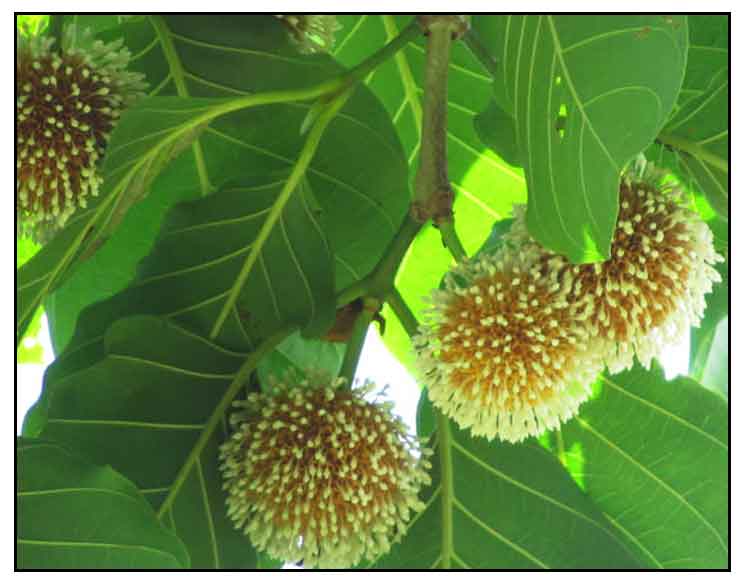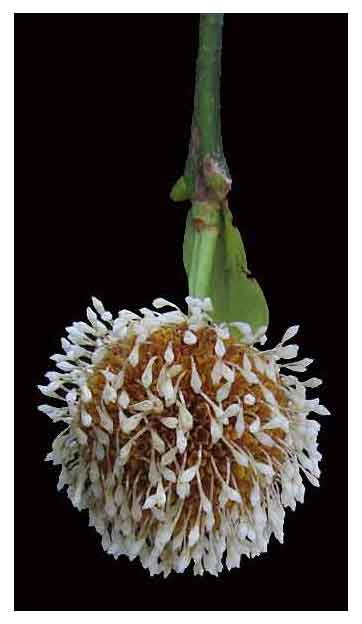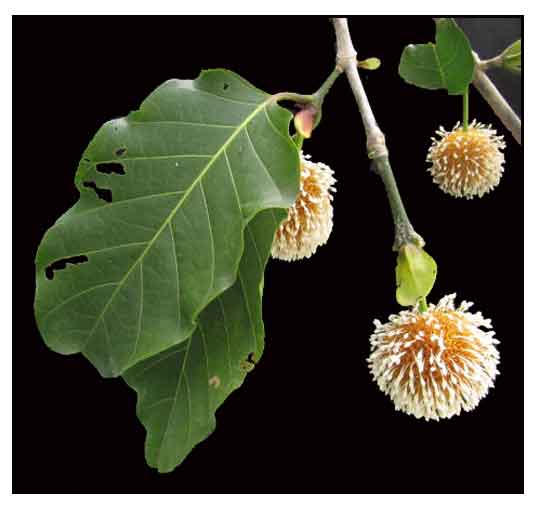 Botany Botany
Mitragyna parvifolia is a large tree growing 40 to 50 feet in height. Stem is erect and branching. Leaves are dark green, simple, opposite, smooth, rounded and decussate. Petioles are 1 to 4 centimeters long. Flowers are in terminal heads, fragrant, creamy-white or yellow, in ball-shaped clusters; peduncle supported by a pair of bract like oblong leaves. Fruits are capsules arranged in globose heads, 2 to 3 millimeters lone, ribbed. Seeds are many, small, 10-ribbed.
 Distribution Distribution
- Tree was spotted in Butuan.
- Native to India.
- Found in tropical and subtropical regions of Asia and Africa.
Constituents
- Stem and bark yield alkaloids, flavonoids, glycosides, and tannins.
- An alcohol extract of bark yielded carbohydrates, alkaloids, phenols, tannins and phytosterols. A benzene extract yielded carbohydrates, flavonoids, and sterols. (2)
- Leaves yield six major oxindolic alkaloids viz. mitraphylline, isomitraphylline, pteropodine, isopteropodine, speciophylline, and uncarine F. Other plant alkaloids are rotundifoline, rhynchophylline, isorotundifoline, rhynchociline, speciocilitine, speciofoline, mitragynine. Plant also yield compounds like pyroligneous acids, aldehydes, ketones, scopoletin, thermophylline, daucosterol, quinovic acid, ß-sitosterol and methyl acetate. (18)
- Leaves yielded four hetero-yohimbine type oxindole alkaloids from an acid base treated chloroform fraction of ethanolic extract of leaves: 16, 17-dihydro-17b-hydroxy isomitraphylline (1), 16, 17- dihydro-17b-hydroxy mitraphylline (2), together with two known alkaloids, isomitraphylline (3) and mitraphylline (4). Mitraphylline was the main alkaloid. (19)
Properties
- Studies have shown analgesic, antipyretic, anti-inflammatory, antimicrobial, antiarthritic, antinociceptive, anticonvulsant, antidiabetic, anxiolytic, antiviral, immunosuppressive, antiurolithiatic properties.
- In Ayurveda, used as antipyretic, anti-arthritis, anticonvulsant, anthelmintic, antimicrobial, antiproliferative, antioxidant.
Parts used
Root bark, leaves, sap, fruits.
Uses
Folkloric
- No reported folkloric medicinal use in the Philippines.
- In Ayurveda, bark used for blood-related diseases.
- In traditional Indian medicine, bark and roots used for fevers colic, muscular pains, stomach burning, poisoning, gynecological problems, cough and edema. Also used as aphrodisiac. Bruised leaves used to promote healing of wounds and ulcers and to alleviate pain.
-
In some parts of India, rice is treated with various tree and seed extracts. Bark and roots used for fever colic, gynecologic problems. Fruit juice used to enhance breast milk secretion in lactating mothers.
- In Andhra Pradesh, fresh leaf juice used to treat jaundice. In Karnataka, India, stem bark used for biliousness. Bark paste applied externally for muscular pains. Bark decoction used for fevers. Powdered bark boiled with fruits and inhaled through the mouth for toothache. (2)
- Sap used by various Indian tribes for treatment of jaundice.
Others
- Timber: Used for making furniture, agricultural implements, cooperages, paper industry, etc.
- Yellow Gold: In some countries, marked as a "Yellow Gold"—as a kratom product or cheaper substitute for kratom. However, to kratom users, it fails in comparison in overall effects.
Studies
• Leaf Alkaloids: Leaves yielded two alkaloids, 16,17-dihydro-17b-hydroxy isomitraphylline (1) and 16, 17- dihydro-17b-hydroxy mitraphylline (2), with two known alkaloids, isomitraphylline and mitraphylline. (3)
• Anthelmintic: Study evaluated a methanolic stem bark extract for anthelmintic activity in vitro against adult earthworm Pheretima posthuma. Results showed significant dose dependent anthelmintic activity at 100 mg/ml. (4) Study of ethanolic and aqueous extract of leaves of M. parvifolia showed significant anthelmintic activity against Pheretima posthuma, demonstrating significant paralysis of worms at higher concentrations of 50 mg/ml, as compared with albendazole (10 mg/ml) as standard reference. (Sahu et al., 2009) (17)
 • Anticonvulsant / Leaves: An ethanol extract of leaves was evaluated for effects in seizures induced by pentylenetetrazole (PTZ) and maximal electroshock convulsive methods in mice. Results showed dose-dependent anticonvulsant effects in both models. (5) • Anticonvulsant / Leaves: An ethanol extract of leaves was evaluated for effects in seizures induced by pentylenetetrazole (PTZ) and maximal electroshock convulsive methods in mice. Results showed dose-dependent anticonvulsant effects in both models. (5)
• Antimicrobial / Bark: Study evaluated the antimicrobial efficacy of M. parvifolia bark and Butea monosperma leaves against human pathogenic microbial strains. M. Parvifolia extracts showed better activity than B. monosperma extracts. (6)
• Anti-Inflammatory / Antinociceptive: An ethanolic extract of dried leaves of Mitragyna parvifolia showed anti-inflammatory activity in a carrageenan-induced paw edema model with an effect equivalent to phenylbutazone. The extract also exhibited marked antinociceptive activity comparable to standard drug Ibuprofen. (7)
• Antioxidant / Leaves: Study on leaves showed high levels of antioxidant activity in successive methanolic extracts which was attributed to high phenolic content. (8)
• Anti-Oxidative Stress Effect/ Leaves: Study evaluated the anti-oxidative stress efficacy in STZ-induced diabetic rats. Significantly increased levels of malondialdehyde were restored to near normal levels with an ethanolic extract of leaves. The anti-oxidative stress effect may be due to the presence of alkaloids, flavonoids, saponins, glycosides and triterpenoids in the extract. (9)
• DHIM / Alkaloid / DPP IV Inhibitor / Anti-Diabetic: DHIM is an indole alkaloid isolated from M. parvifolia. DHIM exhibited marked inhibition of DPP IV. In an in vivo study on neonatal Wistar albino rats treated with STZ, chronic administration of DHIM markedly reduced plasma glucose concentration, increased glucose tolerance in response to glucose loading. GLP-1 and IL-1 were significantly increased in treated diabetic rats. Assay showed DHIM stimulates ß-cell proliferation and reduced pancreatic cell apoptosis. (10)
• Anxiolytic / Stem-Bark: Study evaluated stem-bark extracts and fractions for anxiolytic activity in mice. Results showed all the extracts showed dose-dependent anxiolytic-like activity. The alkaloid rich fraction showed more potency. The activity was probably mediated via the GABAergic system. (12)
• Analgesic / Anti-Inflammatory / Fruits: Study of ethanolic extract of fruit showed very significant analgesic and anti-inflammatory potential. Phytoconstituent study yielded pyroligenous acid, methyl acetate, ketones and aldehydes. (14)
• Anti-Bovine Herpes Virus-1: Study screened 10 medicinal plants for activity against Bovine Herpes virus type-1, causing infectious Bovine Rhinotracheitis disease, abortion in 5-7 month pregnancy in bovines with high economic loss. Four plants, including Mitragyna parvifolia, showed 40-62% protection against BHV-1. (15)
• Antioxidant / Antibacterial / Leaves: Study of ethanolic extract of M. parvifolia leaves showed concentration dependent antioxidant activities compared with standard antioxidants BHA and ascorbic acid, with highest antioxidant activity observed with 500 µg/ml of extract. On antibacterial testing, extract also showed significant inhibition of S. aureus, and some degree of inhibition against P. aeruginosa and E. coli. (Kaushik et al., 2009) (17)
• Anxiolytic / Stem Bark: Study evaluated various extracts of stem bark of M. parvifolia for anxiolytic activity using elevated plus maze (EPM) and marble burying test (MBT) in mice. While all extracts (methanolic, EA, and alkaloid rich fraction) were effective in a dose dependent manner, the alkaloid rich fraction was more potent in producing anxiolytic effects. Results suggest the anxiolytic-lke activities were mediated via GABAergic system. (18)
• Immunosuppressive / Cytotoxic: Study isolated the flavonoids from leaves of three medicinal plants viz. Mitragyna parvifolia, Mangifera indica, and Aegle marmelos and evaluated their in vitro effects on human peripheral blood mononuclear cells using Hepatitis B vaccine containing HBsAg. Results showed the flavonoids at higher doses (25 mg/mg; 50 µl) inhibited HBsAg stimulat4d proliferation of human PBMC cells as well as NO production and also blocked the activation of CD14 monocyte surface marker which re necessary for T cell activation. Results suggest the crude flavonoids from these plants has potential for development as immunosuppressive and cytotoxic agent. (20)
• No Diuretic Effect / Effect on Experimental Urolithiasis: Study evaluated the diuretic efficacy of alcoholic extract of M. parvifolia root and its antiurolithiatic activity in Wistar rats. Root extract failed to show significant diuretic activity. However, the extract significantly (p<0.001) normalized elevated levels of urine and serum parameters in lithiatic rats, with significant improvement in antioxidant status of the kidney. Results suggest utility for the treatment of urinary calculi. (21)
Availability
Wild-crafted.
|

![]()



 Botany
Botany Distribution
Distribution • Anticonvulsant / Leaves: An ethanol extract of leaves was evaluated for effects in seizures induced by pentylenetetrazole (PTZ) and maximal electroshock convulsive methods in mice. Results showed dose-dependent anticonvulsant effects in both models. (
• Anticonvulsant / Leaves: An ethanol extract of leaves was evaluated for effects in seizures induced by pentylenetetrazole (PTZ) and maximal electroshock convulsive methods in mice. Results showed dose-dependent anticonvulsant effects in both models. (